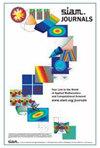统计有限元法的理论保证
IF 1.9
3区 工程技术
Q2 MATHEMATICS, INTERDISCIPLINARY APPLICATIONS
引用次数: 1
摘要
SIAM/ASA不确定度量化杂志,第11卷,第4期,1278-1307页,2023年12月。摘要。统计有限元法(StatFEM)是一种新兴的概率方法,它允许将物理系统的观测与PDE的数值解综合起来,以便在连贯的统计框架中描述它,以补偿模型误差。这项工作提出了一个新的理论分析的StatFEM表明,它具有类似的收敛性质,它是基于有限元方法。我们的结果构成了理想先验和后验之间的2-Wasserstein距离及其StatFEM近似的界,并表明该距离以与有限元解收敛于真实解相同的网格依赖速率收敛。给出了几个数值例子来证明我们的理论,包括一个例子,测试了StatFEM扩展到非线性量时的鲁棒性。本文章由计算机程序翻译,如有差异,请以英文原文为准。
Theoretical Guarantees for the Statistical Finite Element Method
SIAM/ASA Journal on Uncertainty Quantification, Volume 11, Issue 4, Page 1278-1307, December 2023.
Abstract. The statistical finite element method (StatFEM) is an emerging probabilistic method that allows observations of a physical system to be synthesized with the numerical solution of a PDE intended to describe it in a coherent statistical framework, to compensate for model error. This work presents a new theoretical analysis of the StatFEM demonstrating that it has similar convergence properties to the finite element method on which it is based. Our results constitute a bound on the 2-Wasserstein distance between the ideal prior and posterior and the StatFEM approximation thereof, and show that this distance converges at the same mesh-dependent rate as finite element solutions converge to the true solution. Several numerical examples are presented to demonstrate our theory, including an example which tests the robustness of StatFEM when extended to nonlinear quantities of interest.
Abstract. The statistical finite element method (StatFEM) is an emerging probabilistic method that allows observations of a physical system to be synthesized with the numerical solution of a PDE intended to describe it in a coherent statistical framework, to compensate for model error. This work presents a new theoretical analysis of the StatFEM demonstrating that it has similar convergence properties to the finite element method on which it is based. Our results constitute a bound on the 2-Wasserstein distance between the ideal prior and posterior and the StatFEM approximation thereof, and show that this distance converges at the same mesh-dependent rate as finite element solutions converge to the true solution. Several numerical examples are presented to demonstrate our theory, including an example which tests the robustness of StatFEM when extended to nonlinear quantities of interest.
求助全文
通过发布文献求助,成功后即可免费获取论文全文。
去求助
来源期刊

Siam-Asa Journal on Uncertainty Quantification
Mathematics-Statistics and Probability
CiteScore
3.70
自引率
0.00%
发文量
51
期刊介绍:
SIAM/ASA Journal on Uncertainty Quantification (JUQ) publishes research articles presenting significant mathematical, statistical, algorithmic, and application advances in uncertainty quantification, defined as the interface of complex modeling of processes and data, especially characterizations of the uncertainties inherent in the use of such models. The journal also focuses on related fields such as sensitivity analysis, model validation, model calibration, data assimilation, and code verification. The journal also solicits papers describing new ideas that could lead to significant progress in methodology for uncertainty quantification as well as review articles on particular aspects. The journal is dedicated to nurturing synergistic interactions between the mathematical, statistical, computational, and applications communities involved in uncertainty quantification and related areas. JUQ is jointly offered by SIAM and the American Statistical Association.
 求助内容:
求助内容: 应助结果提醒方式:
应助结果提醒方式:


